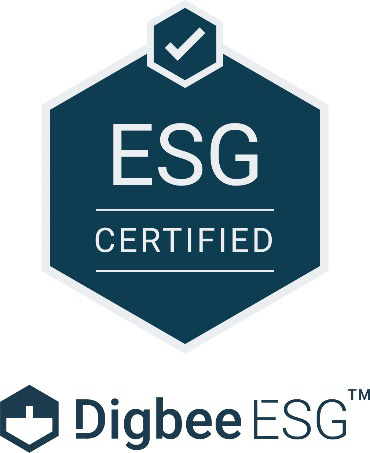Capella’s Løkken copper-rich massive sulfide (“VMS”) project is located approximately 50km SW of the regional centre of Trondheim in Trøndelag County, central Norway. The Løkken claim block covers an area of 210 square kilometres (21,000 Ha) and surrounds the former Løkken underground copper mine which closed in 1987 in response to low copper prices. The former Løkken mine is considered to be one of the largest ophiolite-hosted Cyprus-type VMS deposits (by tonnage) to have been developed in the world, producing an estimated 24Mt @ 2.3% Cu and 1.8% Zn (plus silver and gold credits)1.
The Løkken claim block covers a significant portion of the old Løkken mine infrastructure (shafts, historical mineral processing facilities, railway loading area for concentrate, etc), in addition to multiple satellite occurrences of copper-rich VMS mineralization with varying degrees of development.
The Company’s Summer 2022 field season at Løkken was focused on advancing drill hole targeting within the 5 highest priority target areas - Amot, Hoydal, Grefstofjellet, Halsetasen, and Fjellslett – but with a clear focus on the 5km long Løkken Mine - Hoydal - Amot corridor. Work completed included systematic ground magnetic surveys and soil (Ionic Leach, or “IL”) sampling, with almost 1,000 IL samples having been taken over the Amot, Hoydal and Halsetasen target areas.
The Amot target is now considered to be drill-ready with initial permitting for a maiden core drilling program having now been completed.
Project Snapshot
| Location | 50 km S of Trondheim, Norway |
| Ownership | 100% Capella Minerals Ltd 2.5% NSR to EMX Royalty, with 0.5% purchasable for USD 1M. |
| Status | Near-mine and greenfields exploration |
| Deposit type | High-grade copper-rich VMS deposits |
| Property Size | 21,000 Ha / 210 sq. km. |
| Host Rocks | Ophiolite sequence |
| Age | Ordovician |
| Main Economic Elements | Copper, Zinc, Cobalt, Silver, Gold |
| Access | All weather paved highways and gravel roads |
1 Historic production values quoted above are from Grenne et al. 1999. Capella and EMX have not performed sufficient work to verify the published data reported above, but both Companies believe this information is considered reliable and relevant. (Mineralium Deposita 34, 422–471
Løkken – Regional Setting
The Løkken and Røros (Kjøli) massive sulfide (“VMS”) districts in central Norway lie within the so-called Caledonian orogeny, which is interpreted to have extended from the productive VMS districts in NE Canada (Bathurst Mining Camp, New Brunswick; Buchans District, Newfoundland) and the Appalachian US to northern Norway (Figure 1). Mineralization at Løkken is hosted by a sequence of Ordovician-age metabasalts (mixed pillow and massive basalts) within an overturned ophiolite sequence.
 |
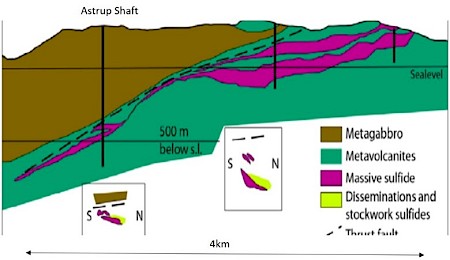 |
Figure 1. Location of the Løkken deposit in the Caledonian orogeny (left) and mine-scale geology (right).
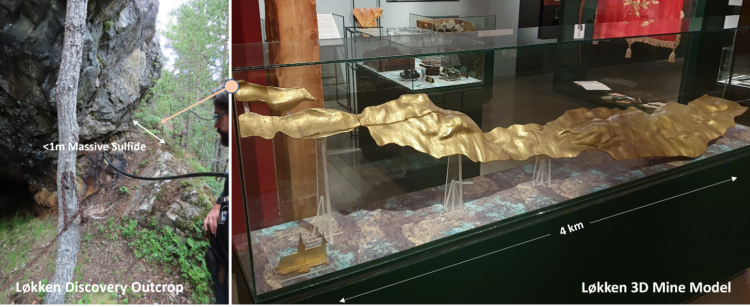
Figure 2. The subtle Løkken discovery outcrop (left) and 3D model of the old Løkken mine (right).
The former Løkken Mine consisted of a stratiform massive sulfide deposit which was approximately 4km in length, reached a maximum depth of 1km, and had an average thickness of 60m1 (Figure 2). Mineralization consisted of massive chalcopyrite, sphalerite, pyrite, and pyrrhotite. Given that VMS deposits typically occur in clusters, field activities at Løkken will follow two main paths i) exploring potential extensions to the known mineralization at Løkken, and ii) advancing priority near-mine targets to drilling.
Løkken Claim Block and Priority Exploration Targets
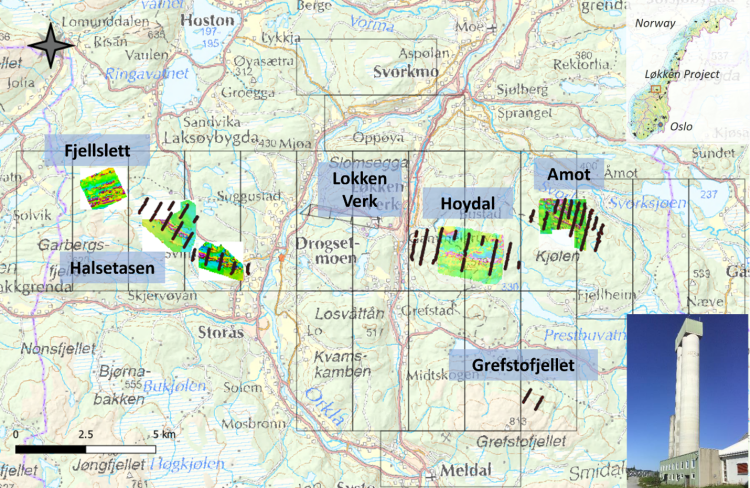
Figure 3. Løkken claim block and the 5 priority exploration targets advanced during Summer 2022.

Figure 4. Select VMS targets on the Løkken claim block – Dragset, Hoydal, Amot.
Capella’s 100%-owned claim block at Løkken is a district-scale (210 sq. km; Figure 3) land holding that surrounds the former Løkken copper mining operations. This claim block covers part of the old Løkken mine, a significant portion of the former mine infrastructure (shafts, historical mineral processing facilities, railway loading area for concentrate, etc), in addition to multiple satellite bodies of VMS mineralization with varying degrees of development (Figure 4). The Norwegian State holds a small relict claim over the mined-out central portion of the old Løkken mine, but this does not affect Capella’s goals of exploring for extensions to known mineralization and drill testing of near-mine priority target areas.
Work completed during the Summer 2022 field season was primarily focused on evaluating the upside potential of the Løkken Mine - Hoydal - Amot corridor, which consists of 5km strike length of favourable stratigraphy for the discovery of new VMS-style deposits. Data from the ground magnetic surveys have now been received and interpreted, however, results from the extensive IL geochemical surveys are mostly pending.
Amot Target
Amot is an undrilled VMS target which lies approximately 5km E of the old Løkken mine. The Amot Cu-Zn-Co target consists of a buried (interpreted depth to target: 150m), 1.5km-long coincident ground magnetic and electromagnetic anomaly considered to be a highly favourable combination for VMS deposits (Figure 5). Initial IL results also suggest anomalous copper, cobalt, and zinc values in the overlying soils. The Amot target is drill-ready with Initial permitting for 5 scout drill holes having now been completed.

Figure 5. Coincident ground magnetic and electromagnetic anomalies at Amot.
Hoydal Target
The Hoydal Cu-Co-Zn target lies between the former Løkken copper mine and Capella’s new Amot target. Work completed by previous operators had focused on evaluating the upside potential of an interpreted feeder zone at Hoydal; this work included the undertaking of diamond drilling along approximately 750m of strike and from which a mineralized envelope of >1% Cu was defined (Figure 6). Capella’s 2022 Summer work program included completing a ground magnetic survey over the main Hoydal target (in addition to immediate extensions), together with systematic Ionic Leach (“IL”) profiles across the main Hoydal trend. Results for the IL samples are still pending.
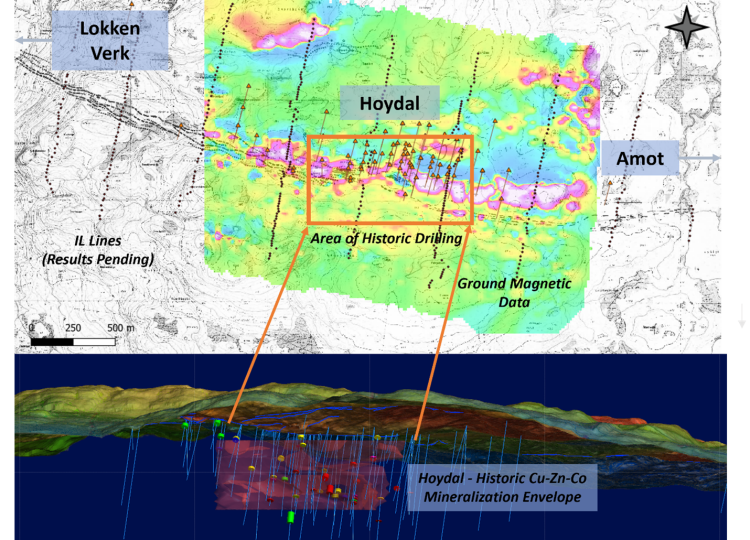
Figure 6. Work completed by Capella at Hoydal during Summer 2022 (ground magnetic survey and IL survey lines), together with the locations of historical diamond drill holes and the historic mineralization envelope2,3.
2 Historical results have not been independently verified by the Company. A potential investor should not place undue reliance on these historical drill results when making an investment decision, nor should they be used as the sole criterion for making investment decisions. There is no assurance that the Company can reproduce such results, or that the historic results described herein will be realized.
3 The historic mineralization envelope does not constitute a mineral resource estimate and the Company is not treating the historic mineralization as a current resource.
H2 2022 / 2023 Work Program
The Company’s 2022 summer field season at Løkken was focused on advancing drill hole targeting within the 5 highest priority target areas - Amot, Hoydal, Grefstofjellet, Halsetasen, and Fjellslett - as defined from the 2021 field season. Work completed included systematic ground magnetic surveys and soil (ionic leach) sampling, with results from the majority of the IL samples still pending. The Amot target is considered to be drill-ready with initial permitting for 5 scout holes having now been completed (with logistical and environmental considerations dictating the precise start date for drilling). A detailed review of the historic diamond drill data from Hoydal is also underway.
Historical Photographs – Former Løkken Mining Operations

Open stope in Løkken underground operations

Haulage cart in old Løkken mine
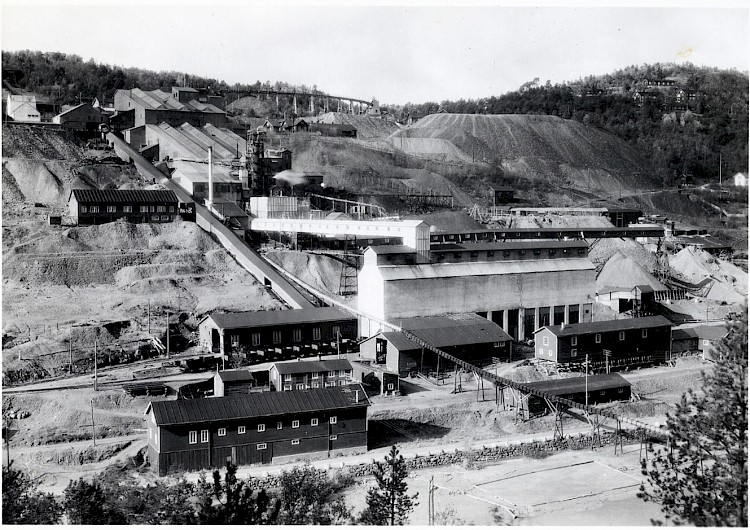
Former processing facilities at Løkken

Electrified railway joining Løkken with the deepwater port at Orkanger

